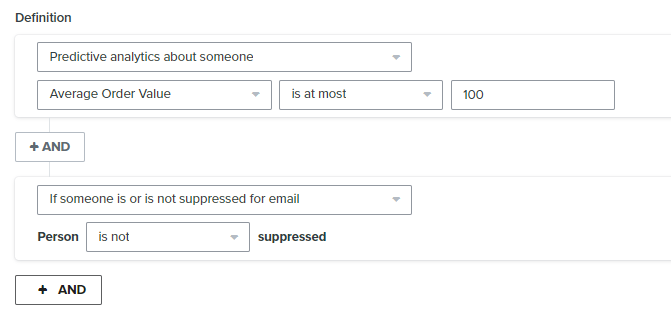The Definitive Guide to Klaviyo
The Definitive Guide to Klaviyo
If you want to stay ahead of the crowd, how your ecommerce business handles email communications and outreach matters. Klaviyo is an incredible tool for managing not only your outgoing emails but also collecting and retaining crucial analytics that can help you craft the most effective campaigns for both new and existing customers. The Klaviyo platform is better than ever, with features that will streamline and maximize your communications.
This guide will walk you through everything you need to know to dominate your email game with Klaviyo in 2024. From set-up through analytics, this overview provides you with the tools to succeed with Klaviyo on your side.
Understanding Klaviyo
Klaviyo is an automated platform designed specifically for ecommerce businesses, offering a comprehensive suite of tools beyond just email campaigns. It includes features for flow automation, SMS messaging, email acquisition, and more.

Not just recognized as a Customer Relations Manager (CRM) platform, Klaviyo has also unveiled a fresh program enhancement known as Customer Data Platform (CDP).
Here are just some of the functions Klaviyo has to offer:
- Email marketing
- Automation
- Segmentation
- Analytics
- Integration
- Personalization
- SMS Marketing
- Sign-up Forms
The platform’s advanced metrics and analytics track customer preferences and behaviors, providing a user-friendly dashboard that allows for efficient management of various marketing strategies, including email and SMS campaigns.
With these tools, you can easily link Klaviyo to your shopping platforms, like Shopify (including Order Updates!). This integration enables you to develop a sophisticated email program that incorporates personalized email campaigns, product recommendations, and more, enhancing the overall customer experience.
The automated flows have undergone a recent transformation, now introducing a modern and intuitive interface. This revamped look not only simplifies the process of creating and optimizing flows but also enhances troubleshooting for existing ones. With improved features, working on automated flows has become more efficient and user-friendly.
Setting Up with Klaviyo
If you’re already working on other platforms, you might be hesitant to connect with Klaviyo because you’re worried about losing data or functionality, but nothing could be further from the truth. Shopify → Klaviyo is one of the most popular connections between ecommerce platforms and CDP/CRM systems, so let’s show you how easy it is to link the two accounts without losing any data or assets. Here’s a detailed step-by-step guide.

Connecting Klaviyo and Shopify
1) Set up a Klaviyo account
If you don’t have an account, you’ll need one. You can get started for free, and plan pricing is based on your number of contacts. There’s a handy cost calculator on the Klaviyo Pricing page, which is a nice feature.
2) Log in to your Klaviyo account
When you get to your dashboard, look for the tab labeled Integrations.
3) Add Shopify as an integration
Find Shopify on the list of available integrations and select it. This will trigger a prompt with your next instructions.
4) Connect your Shopify store
The instructions will guide you to enter your Shopify information; you may need to log into your Shopify account to confirm the connection.
5) Configure and personalize your settings
In Klaviyo, select and save the data you want to share between the platforms. You can change these preferences at any time.
6) Sync your data
Once you’ve selected your data, it’s time to initiate the sync between the platforms. A notification will let you know when this is complete.
7) Verify the connection
Check both platforms, Klaviyo and Shopify, to ensure that the connection and sync worked. You should see recent data from your Shopify store in your Klaviyo dashboard.
8) Get to work
With Klaviyo and Shopify connected, you can get started on your outstanding new email campaigns!
Connecting your shopping platform to Klaviyo might not be the only potential data loss you’re worried about. If you’re already using an email platform like Mailchimp, you might be concerned about losing contacts in the migration. But don’t worry; there’s a helpful step-by-step guide to migrating from Mailchimp on Klaviyo’s website.
Klaviyo Email Flows
Email flows are a key feature of Klaviyo’s platform, and these are critical to streamlining your outgoing emails. When you set up automated email flows, you save time and resources while still personalizing your content and promptly replying to customers. When you set up email flows, you reap the benefits of:
- Automation
- Personalization
- Customer Acquisition
- Timely Communication
- Lead Nurture
- Increased Conversions
- Consistent Brand Messaging
- Scalability
While you can later add to your email flows, there are a few that you should set up to get started. These are:
Welcome Flow: This flow is initiated when a user subscribes to your website, often incentivized by a discount or special offer. They can subscribe through various channels, such as a sign-up form, a pop-up overlay, the footer of the website, the checkout page, or from an uploaded list. Once subscribed, the user receives the Welcome Flow, a series of emails that introduces your brand, provides valuable information about your business, and encourages engagement with your content across all platforms. This flow capitalizes on the initial interest shown by the subscriber, who was drawn in by the initial subscription incentive.

Abandoned Cart Flow: Create a flow that is triggered by an ‘abandoned cart’ event. When shoppers leave items in their cart on your shopping platform, you’ll have a series of emails in place to encourage them to complete their purchase, which can also include savings or incentives to make the sale more enticing.

Browse Abandonment Flow: This flow targets visitors who view products on your site but don’t proceed to checkout. This flow is triggered by the ‘Viewed Product,” and is typically designed to be a “lighter touchpoint” compared to the Abandoned Cart Flow. It can be customized with personalized emails or SMS that showcase the product they were interested in, re-engaging customers and encouraging a return visit to your store.

Some other email flows you might want to consider are a Post-Purchase flow, an Order Confirmation/Transactional flow, a Re-engagement Flow, and an Upsell or Cross-Sell Flow.
Email Campaign Strategies
It’s not enough to set it and forget it when it comes to your email campaigns. Klaviyo has the tools to help you craft effective email series for all of your brand’s needs. Let’s take a look at what some of those campaigns might look like:
Trust/Content Campaigns: These campaigns provide your audience with valuable, up-to-date content about your business. You might want to include educational items about your products, link to your blog, or send a newsletter. A solid strategy for trust/content campaigns is to segment your audience by their interests and preferences to ensure maximum engagement.
Product Promo Campaigns: Product promo campaigns shine a spotlight on specific products or services that you’d like to sell more of, and email campaigns are a great way to target potential buyers. You can segment your audience based on past purchases or send to your entire audience to drum up interest in the featured product.
Sales Events Campaigns: These campaigns announce and promote upcoming and ongoing sales events, special offers, or discounts. You can segment your audience to target specific purchase behaviors or send to your entire audience for sales that apply to everyone.
Of course, the question always remains: how many emails are too many emails? You want to spread your message to the world, but you don’t want to bombard your audience to the point where they no longer engage with your emails. While this will vary by your industry and what type of content you’re sending, here’s a set of general guidelines:
Smaller List (Up to 10,000): 3 – 5 emails per month
Medium List (10,001 to 50,000): 8 – 12 emails per month
Larger List (50,001+): 15 or more emails per month
You should always track your analytics and adjust your numbers accordingly.
Before we move on to more features and best practices, let’s include one of those best practices here since we’ve already touched on it. That best practice is segmentation. Email segmentation helps you select the appropriate audience for all your campaigns and email flows. Here are some ways that you can choose to segment your audiences:
1) Demographic Segmentation
You can use Klaviyo’s segmentation tools to categorize subscribers based on demographic data like age, location, or gender. Demographic segmentation is helpful for identifying target audiences for specific products or services.
2) Behavioral Segmentation
With Klaviyo, you can track user behavior, such as purchase history, website interactions, and email engagement. This segmentation helps you create target audiences to increase sales and engagement.
3) Preferences and Interests Segmentation
Klaviyo’s preference centers and surveys help you gather data on subscriber interests. Targeting campaigns based on preferences and interests helps keep customers engaged and more likely to purchase.
4) Lifecycle Segmentation
With Klaviyo, you can use lifecycle-based segmentation to tailor campaigns to subscribers at different stages of their customer journey. This segmentation lets you decide how to target customers for acquisition, retention, and re-engagement.
5) Engagement Segmentation
You can identify and segment subscribers based on their level of engagement with your emails. This is helpful when crafting both engagement and re-engagement campaigns.
Klaviyo has further enhanced its segmentation capabilities with the launch of Segments AI, a feature that allows you to describe your desired segment based on preferences, behavior, and engagement, and the system intelligently defines and builds a targeted segment for use.
Remember, even with automation, you still need to monitor your metrics and make adjustments based on the analytics. The reporting features on Klaviyo are exceptional for optimization based on your dashboard data.
Advanced Klaviyo Features
When using Klaviyo, you want to make sure you’re taking advantage of the advanced features available to you. These features are built to be useful and user-friendly, so don’t miss out on them.
Predictive Analytics: Klaviyo’s predictive analytics use machine learning to predict your customers’ behavior. You can filter the metrics to look at segments like gender, age, location, and lifetime value, among others. These metrics can help you further personalize campaigns, including exclusive offers or sales that target your desired audiences.

Customizable Reports: Klaviyo offers a number of ways to customize your reports based on the data you most need to effectively run your email campaigns. Choose the metrics that matter most to your business to gain critical insight into your KPIs like conversions, engagements, revenue, and more.
SMS Marketing: Klaviyo’s SMS marketing feature allows you to connect with your customers anywhere, anytime. This feature allows you to create cross-channel communications that increase engagement and conversions. Adding SMS messaging to your pricing plan offers the opportunity to reach a broader audience than email alone.
SMS Lead Generation: Klaviyo integrates pop-ups, sign-up forms, and other lead-generating tools to encourage customers to join your SMS list. By placing these forms and pop-ups where customers are most likely to see them, you can combine them with special offers or incentives to further boost your new customer leads.
Remember that Klaviyo regularly updates their features and capabilities, so it’s a good practice to read their news releases and announcements. You don’t want to miss out on any important information.
Klaviyo Best Practices for 2024
To get the most from your Klaviyo account, we’ve compiled a list of features and best practices for you to incorporate into your upcoming campaigns:
1) Crafting Compelling Subject Lines and Optimizing Preview Text
Subject Lines Best Practices: Create concise, engaging subject lines that encourage opens. Personalize when possible and use urgency or curiosity to capture attention.
- Klaviyo Feature to Use: Klaviyo’s personalization tokens dynamically insert customer names or other personalized information into subject lines.
Preview Text Best Practices: Optimize preview text to complement the subject line and provide a preview of the email’s content. Keep it concise and compelling.
- Klaviyo Feature to Use: Klaviyo’s preview text editor to customize the preview text for different segments or campaigns.
2) Testing and Variations in Campaigns
Testing Frequency Best Practices: Establish a regular testing schedule to analyze campaign performance. Test different elements, including content, images, and send times.
- Klaviyo Feature to Use: Klaviyo’s A/B testing and reporting features offer you insights into what resonates with your audience.
Content Variations Best Practices: Experiment with A/B testing to understand what types of content resonate best with your audience. Test variations in copy, images, and calls to action.
- Klaviyo Feature to Use: Leverage Klaviyo’s A/B testing capabilities to automatically test different versions of your emails and determine the most effective content.
3) Prioritize Email Deliverability and Optimizing Delivery Rates
List Hygiene Best Practices: Regularly clean your subscriber list by removing inactive or bounced email addresses. Ensure your content aligns with spam regulations.
- Klaviyo Feature to Use: Klaviyo’s delivery insights help you monitor delivery rates to identify and address any potential deliverability issues.
4) Review and Maintain a Healthy, Engaged Subscriber List
Engagement Metrics Best Practices: Monitor engagement metrics, such as click-through rates and conversion rates. Identify and re-engage inactive subscribers.
- Klaviyo Feature to Use: Klaviyo’s engagement tracking and segmentation features help you better target specific audience segments based on their level of engagement.
5) Leverage Customer Data for Personalized Marketing Strategies
Leveraging Customer Data Best Practices: Utilize a Customer Data Platform (CDP) to centralize and manage customer data effectively. Analyze customer behaviors and preferences to create targeted, personalized marketing campaigns.
- Klaviyo Feature to Use: Klaviyo’s Customer Data Platform offers tools for data integration, segmentation, and analysis. It enables real-time data synchronization and transformation, ensuring accurate and up-to-date customer profiles for more effective personalization and segmentation.

Klaviyo has additional tools that you can explore to maximize and optimize your campaigns. You can preview all your messages before they go out, and use dynamic content to keep up with your ever-changing subscriber list.
Future Trends and Predictions
Regularly checking Klaviyo’s official announcements, blogs, and release notes will keep you updated on the platform’s evolution. Keep an eye out for potential enhancements, such as AI-driven personalization, advanced automation, and integrations with new technologies. To stay ahead in email marketing with Klaviyo, continuous learning is key. Klaviyo offers webinars, workshops, and training sessions to stay updated on new features and best practices. There are also community forums to connect with other users, share insights, and learn from their experiences.
Closing Thoughts
Klaviyo’s capabilities, combined with a proactive and innovative approach, empower businesses to create personalized and engaging email marketing experiences. Staying informed, experimenting with new strategies, and embracing data-based decision-making will contribute to the success of your campaigns and your business. Adapt your strategies based on industry changes, technological advancements, and evolving audience preferences. Klaviyo’s dynamic features and commitment to innovation make it a valuable tool for delivering compelling email experiences in 2024 and beyond.
About the Author: Eliza Spencer brings over a decade of experience in digital marketing to the table, with a background that spans from in-house roles to agency work, specializing in Paid Media and Lifecycle Marketing. As the Lead Lifecycle Marketing Strategist at adQuadrant, she’s dedicated to pushing the boundaries of Email and SMS marketing. Beyond her digital endeavors, you’ll find Eliza pouring her energy into her small businesses, enjoying quality time with her two Frenchies, and embracing new challenges like mastering golf or hitting the lanes for a game of bowling with her husband.




